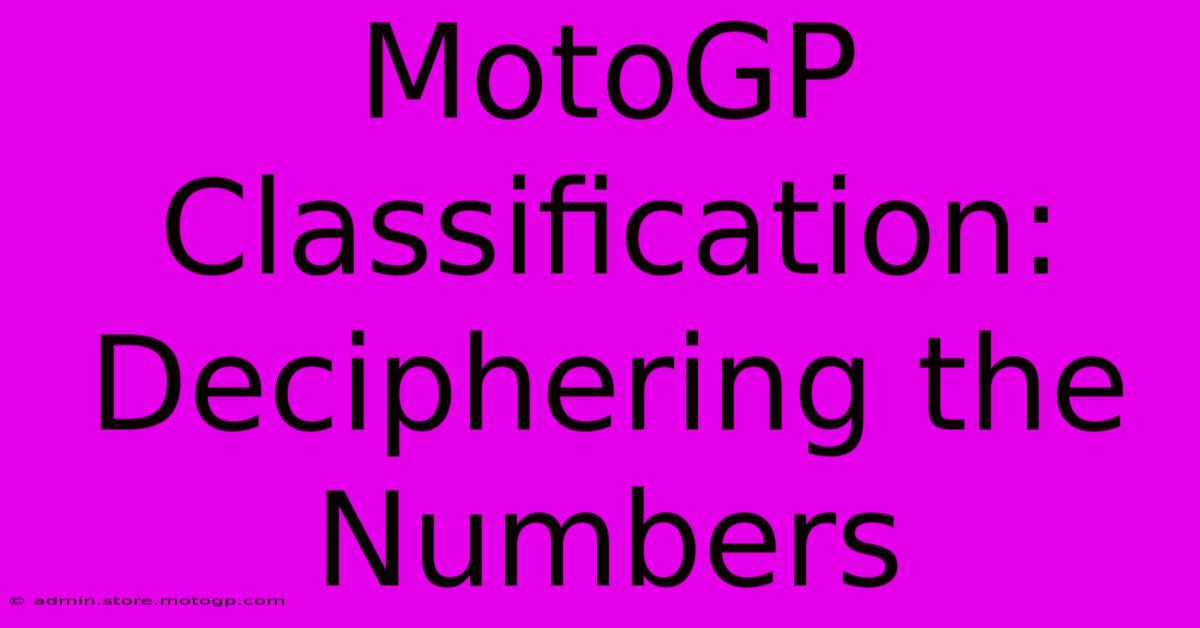MotoGP Classification: Deciphering The Numbers

Table of Contents
MotoGP Classification: Deciphering the Numbers
MotoGP, the pinnacle of motorcycle racing, boasts a thrilling spectacle of speed, skill, and strategy. But understanding the final classification can be tricky for newcomers. This guide breaks down the MotoGP classification system, explaining the points awarded, tie-breakers, and how the championship standings are determined.
Understanding the MotoGP Points System
The heart of the MotoGP classification lies in its points system. Riders earn points based on their finishing position in each Grand Prix race. The points allocation is as follows:
- 1st Place: 25 points
- 2nd Place: 20 points
- 3rd Place: 16 points
- 4th Place: 13 points
- 5th Place: 11 points
- 6th Place: 10 points
- 7th Place: 9 points
- 8th Place: 8 points
- 9th Place: 7 points
- 10th Place: 6 points
- 11th Place: 5 points
- 12th Place: 4 points
- 13th Place: 3 points
- 14th Place: 2 points
- 15th Place: 1 point
Important Note: Only riders who finish the race within the allotted time receive points. DNF (Did Not Finish) results earn zero points.
Sprint Race Points: A New Addition
Since 2023, MotoGP has introduced sprint races on Saturday. These shorter races award points, although fewer than the main race on Sunday. The points allocation for sprint races is:
- 1st Place: 12 points
- 2nd Place: 9 points
- 3rd Place: 7 points
- 4th Place: 6 points
- 5th Place: 5 points
- 6th Place: 4 points
- 7th Place: 3 points
- 8th Place: 2 points
- 9th Place: 1 point
These sprint race points are added to the rider's and team's overall points tally for the Grand Prix weekend.
Determining the Championship Standings
The MotoGP World Championship is decided over a season of multiple Grand Prix races. The rider and team with the highest accumulated points at the end of the season are crowned champions.
Tie-Breakers: When Points are Equal
In the unlikely event of a tie in points at the end of the season, several tie-breakers are used to determine the champion:
- Number of race wins: The rider or team with more race wins takes precedence.
- Number of second-place finishes: If the number of wins is equal, second-place finishes are considered.
- Number of third-place finishes: This continues down the order of finishing positions until a clear winner is determined.
- Results from the last race: If a tie still persists, the result from the final Grand Prix of the season is the deciding factor.
Beyond the Numbers: Understanding the Implications
While the points system is crucial, understanding the classification also involves considering other factors like:
- Consistency: Regularly scoring high points demonstrates a rider's reliability and consistency.
- Race Strategy: A rider's performance isn't solely about speed; strategic decisions during the race also play a significant role.
- Team Performance: The performance of a rider is often intertwined with the team's technical prowess and support.
Conclusion: Mastering the MotoGP Classification
Understanding the MotoGP classification system allows you to follow the championship with greater insight and appreciation. By understanding the points system, tie-breakers, and the factors that contribute to the final standings, you can more deeply engage with the thrilling world of MotoGP racing. So, next time you watch a race, you'll be equipped to decipher the numbers and appreciate the nuances of this high-octane sport.

Thank you for visiting our website wich cover about MotoGP Classification: Deciphering The Numbers. We hope the information provided has been useful to you. Feel free to contact us if you have any questions or need further assistance. See you next time and dont miss to bookmark.
Featured Posts
-
Famous Motorcycle Riders And Their Love For The Open Road
Feb 19, 2025
-
The Ultimate Moto Gp Wins Record Can Anyone Beat It
Feb 19, 2025
-
Cota Lot H The Best Option
Feb 19, 2025
-
The Spirit Of Moto Gp Passion Dedication And Victory
Feb 19, 2025
-
Moto Gp Crash The Story Behind The Scars
Feb 19, 2025
